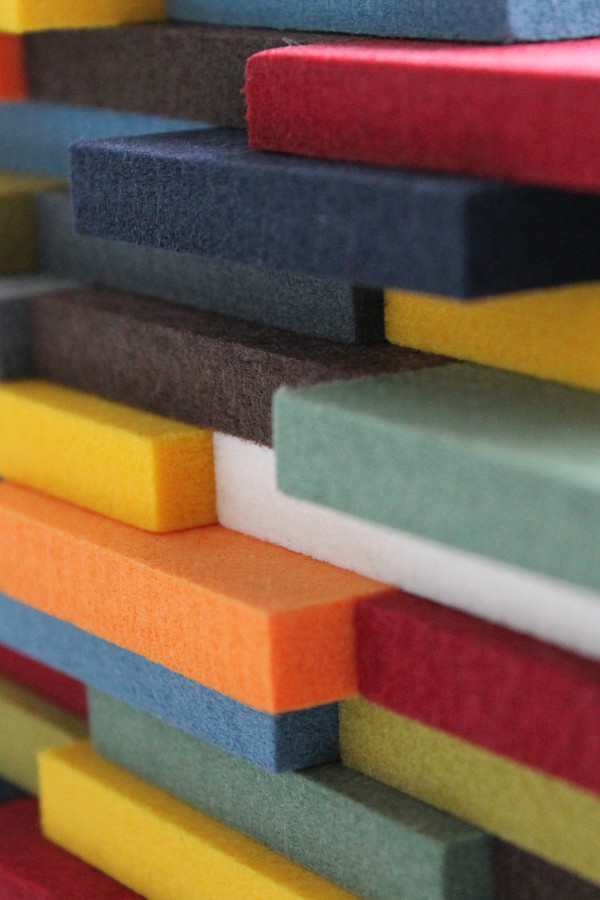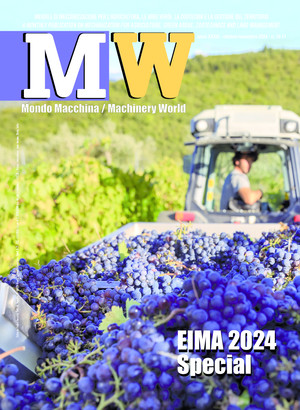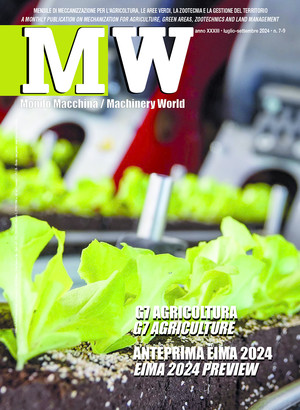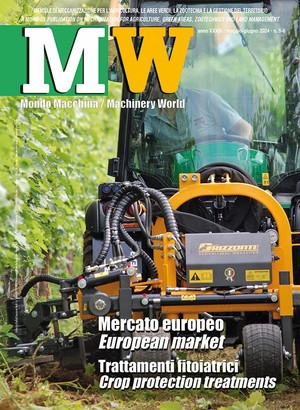
Sound-absorbing materials: research, applications
Wide technical and experimental activity has developed in recent years, in terms of innovative materials for the coatings and roofs of cabins and mechanical parts. Many solutions are already applicable to industrial production, which also include biomaterials and fabrics that can significantly reduce the noise of machines, ensuring greater comfort and safety for operators
Machinery for the agricultural sector aims at efficiency, reliability and flexibility. Smart materials and technology solutions, supported by appropriate design, can vastly improve a machine’s performance set without imposing size and functional changes. The strict parameters for environmental protection defined by European regulations have positive consequences: by imposing the reduction of harmful emissions by machines, and consequently of consumption, the standards on emissions bring about not only an environmental impact, but also an increase in operating comfort. At the same time, incentives for the purchase of agricultural machinery, allocated by the Ministry of Agricultural Policy and entrusted to INAIL, are designed to encourage the choice of machines with characteristics of efficiency, environmental friendliness and safety. Among these key factors, it is possible to consider safety as the element that most influences the definition of the requirements that the products must be able to meet with success. In particular, exposure to noise pollution resulting from the inevitable noise emission from the machines and equipment is a particularly important issue: even if in a non-ongoing manner, since they are periodic and discontinuous operations, the equipment and the machines used in agriculture expose operators to high noise levels, which pose the risk of disorders, both auditory (deafness, hearing loss from noise) and extra-auditory (such as high blood pressure, nervousness, anxiety, insomnia, stomach hyperacidity).
Whether it is medium and large self-propelled or towed agricultural machines, soil machines, equipment for the maintenance of orchards, vineyards, landscaping and sports facilities, for working wood, snow or haymaking, noise reduction is an issue that needs effective and targeted responses.
A particularly low internal noise level makes a cabin significantly more comfortable, allowing a prolonged working stay, while the external noise containment of vehicles means less impact for the operators, as well as for the fauna.
Various types of advanced and eco-sustainable materials are able to meet in a targeted and efficient way the noise reduction needs of the agricultural sector. It is a virtuous cycle that causes materials springing directly from this sector, specifically secondary and agricultural waste products that would otherwise be destined for disposal, are used for making the sound-absorbing panels in biocomposite material MC# 6968-04. A combination of leaves and natural fibres is applied on rigid panels, in order to increase the sound absorption and attenuation properties. The panels are completely biodegradable and have a decorative surface consisting of fibres aggregated by means of a binder free of pesticides, plasticizers and solvents. The natural constituents give the material a characteristic scent, variable depending on the type of plants used. The surface of the panels is subjected to molding under high temperature and pressure, then bonded to the base layer by means of a modified starch-based adhesive. The wood fibre support is made from MDF, a material with intrinsic resistance to fire, whose surface presents fissures (open section below 9%) and perforated areas (open section below 44%).
There is a constant growth in the number of materials with recycled content of various origin and nature, both post-industrial and post-consumer, such as the thin (1.3 mm) smooth and flexible sound-absorbing sheets of recycled polyester fibre MC# 7211-01. These heat-shapeable sheets with dedicated density are produced through an innovative process of calibrating and heat-fusing with recycled PET bottles, fully recyclable at the end of their life cycle in areas equipped with the infrastructure for recycling textile materials. The compressed fibre stratification provides an apparently compact surface, which is actually finely structured and endowed with a specific porosity, able to absorb sound waves, effectively preventing their reflection. The flexibility of the sheets allows the creation of non-linear structures and satisfies both aesthetic and functional design requirements. The sublimation printing enables customizing and decorating the surface, allowing high resolution printing.
Recycled materials of natural origin such as cork are particularly suited for the production of printed panels and elements in composite materials. MC# 7485-01 has valid acoustic and thermal insulation characteristics. Cork is a material with inherent antimicrobial properties, hypoallergenic, antistatic with low emissions, and this composite is easily coloured with bright colours.
The rigid and semi-rigid products are joined by alternative types, such as the flexible sound-absorbing sheet MC# 5771-01, versatile and durable, with a thickness of little more than 3 mm. It is a patented membrane consisting of natural rubber, whose performance has been tested by independent bodies such as Riverbank Acoustical Laboratories, NGC Testing Services and Intertek ETL/Semko. It is waterproof and resistant to mould and mildew, as well as highly resistant to UV rays. A single layer is able to absorb up to 30 dB, depending on the frequencies. Where necessary, the product can be completed through the use of a sound-absorbing sealant.
Self-shaping products such as pastes, foams and coatings, allow direct and targeted application on the substrates and are particularly suited to selectively impart sound-absorption characteristics to existing parts, even with complex shapes. A particularly interesting example, usable for the coating of non-porous materials, including stainless steel, galvanized iron, aluminium and reinforced plastic composite materials, is the soundproofing viscoelastic coating MC# 5580-03: it is a patented product, constituted by a modified acrylic resin and latex, magnesium silicate, calcium carbonate and mica. It allows a sound reduction from 6 dB to 20 dB, is easily applicable by brush, roller, sprayer or with a sprayer without air, and dries in less than 20 minutes. It is non-toxic, water soluble, with ultra-low (<30 g/l) VOC emissions, non-flammable (according to the FMVSS302 standards concerning the flammability of materials used for the passenger compartments of motor vehicles) and fully meets the European Union’s RoHS (Restriction of Hazardous Substances) directive.
Textile products that are light yet highly efficient, such as the translucent fabric MC# 6827-03, have excellent sound-absorption characteristics over a wide range of frequencies. These materials comply with the strictest European standards, combining low flammability provided by the fibre they are made of, polyester Trevira® CS, and an absorption coefficient of 0.81 and 0.71 to 800 and 5,000 Hz, respectively.
Excellent low weight characteristics, as well as resistance to scratching, are also offered by the sound-absorbing panels MC# 7661-01, consisting of a fibre-reinforced composite that owes its soundproofing properties, adaptable to specific frequencies, precisely to the highly compressed polyester fibres it is made of. These sheets, available in a variety of thicknesses, degrees of hardness and colours, are resistant to water and oil, free from odours, and do not generate dust during cutting and processing. They can also be easily covered with fabrics, sheets or films, and custom-modelled into three-dimensional shapes.
Another prized property, not offered by most sound-absorbing products, is transparency, which increases visibility. The patented process of selective etching of highly durable polymeric sheets MC# 7607-01 makes sound-absorbing acrylic or PETG panels transparent and otherwise inherently sound-reflecting. The microcuts are made with a patented laser technology, and the cutting paths are designed to impart sound-absorbing properties, to reduce unwanted noise in indoor environments. Forcing the air friction between these slits, the surface transforms the sound waves into heat, without the need to resort to porous fibre materials. To optimize their acoustic performance, these sheets, which can be personalized with prints, logos or signs, must cover 30-50% of a vertical or horizontal surface.
Research and industrial applications: “connexion” at EIMA International
Better performance of agricultural machines, more safety, and more comfort for operators. These are the objectives pursued by the research on new materials for agricultural equipment components that emerged during the meeting on the topic “New materials for components”. The meeting was promoted by the magazine Mondo Macchina/Machinery World in collaboration with Comacomp and Material Connexion, and was held on November 11 in Bologna as part of EIMA International. The reduction of noise and vibration in the cabin, arms able to withstand ever increasing loads, coatings for engines that improve their performance and reduce emissions, compounds that dissipate heat acting as thermal insulators (as was illustrated during the meeting); there are many fields of applications for new material research. The detailed explanation was given by Claudia Reder, senior researcher at Mcx (Material Connexion), a company established in the USA in 1997, and which opened an office in Milan in 2002. “Mcx is an international research centre - said Claudia Reder - but it is also a network of relationships to bring together those seeking a material with those who produce it. The ‘materials library’ catalogues over seven thousand different materials, with a description of their characteristics and possible uses.” Among other things, this is research that meets environmental sustainability - as was emphasized during the meeting - because many of the new compounds are derived from agricultural processing waste, and quiet machines do not frighten the animals. “The need for machines with special characteristics of efficiency and ergonomics is deeply felt, especially where there are large cultivated areas - explained Alessandro Malavolti, Chairman of Comacomp - such as in South and Central America, Northern Europe, Australia, and some countries of the former Soviet Union. Here machines have now reached a size and a level of technical complexity that are hard to exceed, and what we seek is to improve their performance through research on innovative materials that can enable a further leap in quality.” “In Italy - concluded Malavolti - there are many small companies of excellence that are investing in this area.”








